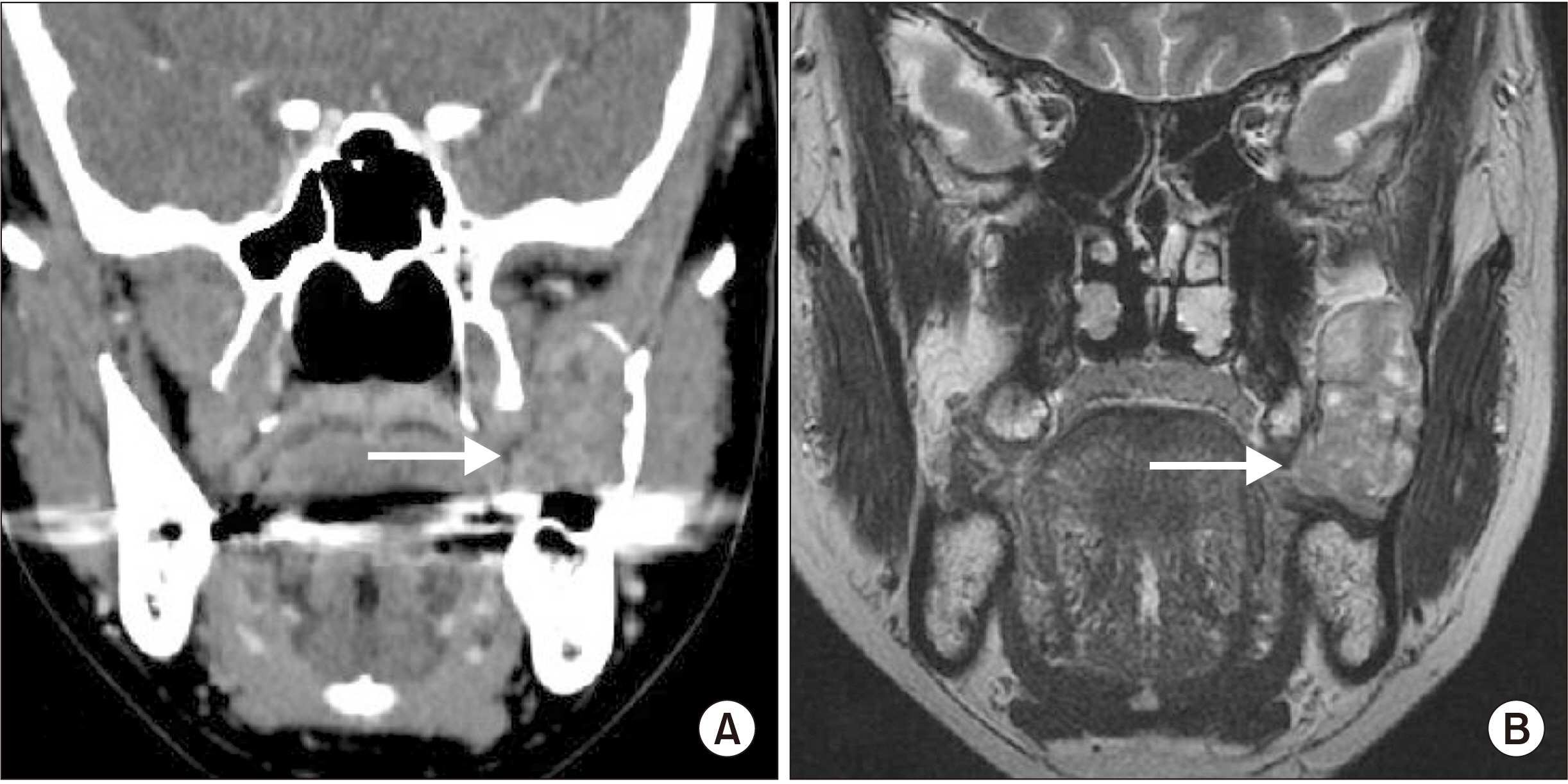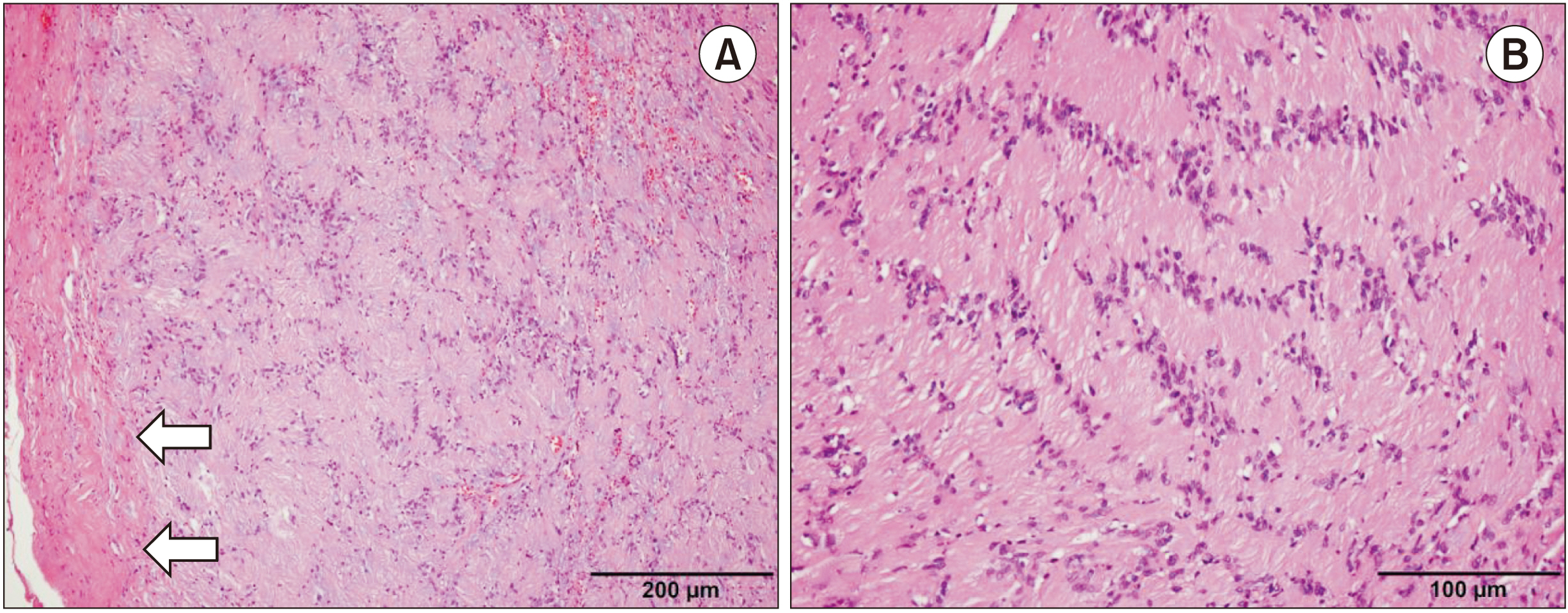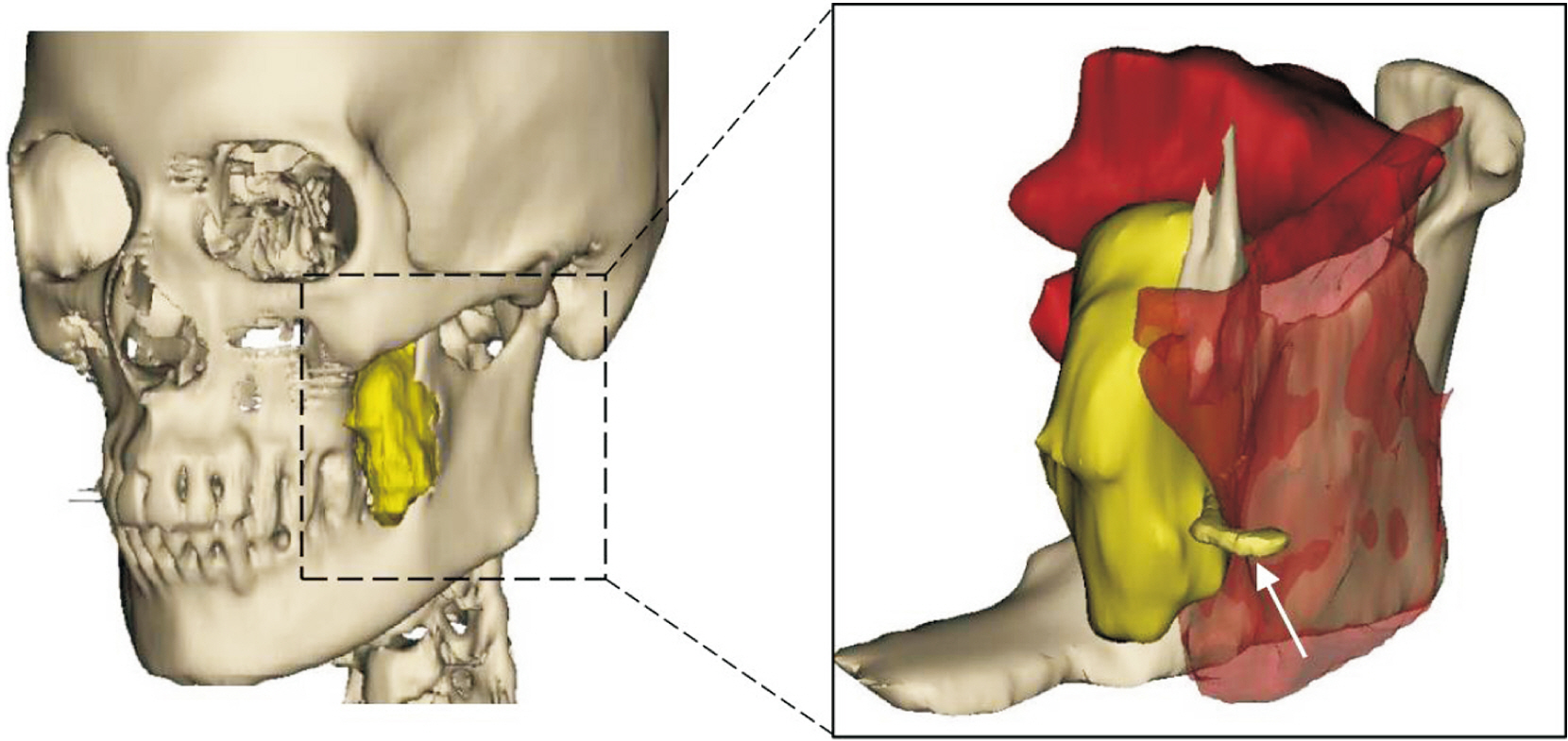J Korean Assoc Oral Maxillofac Surg.
2023 Jun;49(3):148-151. 10.5125/jkaoms.2023.49.3.148.
Buccal nerve schwannoma mimicking a salivary gland tumor: a rare case report
- Affiliations
-
- 1Department of Oral and Maxillofacial Surgery, Gangnam Severance Hospital, Yonsei University College of Dentistry, Seoul, Korea
- 2Department of Oral Pathology, Oral Cancer Research Institute, Yonsei University College of Dentistry, Seoul, Korea
- KMID: 2544317
- DOI: http://doi.org/10.5125/jkaoms.2023.49.3.148
Abstract
- Schwannomas are benign tumors originating from myelinating cells constituting nerve sheaths but rarely contain cellular elements of the nerve. The authors encountered a 47-year-old female patient with a schwannoma on the anterior mandibular ramus arising from the buccal nerve, measuring 3 cm×4 cm. Surgical resection was performed with preservation of the buccal nerve via microsurgical dissection. After one month, the sensory function of the buccal nerve was recovered without complications.
Keyword
Figure
Reference
-
References
1. Fehlings MG, Nater A, Zamorano JJ, Tetreault LA, Varga PP, Gokaslan ZL, et al. 2016; Risk factors for recurrence of surgically treated conventional spinal schwannomas: analysis of 169 patients from a multicenter international database. Spine (Phila Pa 1976). 41:390–8. https://doi.org/10.1097/brs.0000000000001232. DOI: 10.1097/BRS.0000000000001232. PMID: 26555828. PMCID: PMC4769652.
Article2. Crist J, Hodge JR, Frick M, Leung FP, Hsu E, Gi MT, et al. 2017; Magnetic resonance imaging appearance of schwannomas from head to toe: a pictorial review. J Clin Imaging Sci. 7:38. https://doi.org/10.4103/jcis.jcis_40_17. DOI: 10.4103/jcis.JCIS_40_17. PMID: 29114437. PMCID: PMC5651654.
Article3. Kurup S, Thankappan K, Krishnan N, Nair PP. 2012; Intraoral schwannoma--a report of two cases. BMJ Case Rep. 2012:bcr1220115389. https://doi.org/10.1136/bcr.12.2011.5389. DOI: 10.1136/bcr.12.2011.5389. PMID: 22778466. PMCID: PMC3417034.
Article4. Shim SK, Myoung H. 2016; Neurilemmoma in the floor of the mouth: a case report. J Korean Assoc Oral Maxillofac Surg. 42:60–4. https://doi.org/10.5125/jkaoms.2016.42.1.60. DOI: 10.5125/jkaoms.2016.42.1.60. PMID: 26904498. PMCID: PMC4761576.
Article5. Yumuşakhuylu AC, Sari M, Topuz MF, Bağlam T, Binnetoğlu A. 2014; Trigeminal schwannoma extending into the parapharyngeal space. J Craniofac Surg. 25:e328–30. https://doi.org/10.1097/scs.0000000000000593. DOI: 10.1097/SCS.0000000000000593. PMID: 24978683.
Article6. Perkins D, Stiharu TI, Swift JQ, Dao TV, Mainville GN. 2018; Intraosseous schwannoma of the jaws: an updated review of the literature and report of 2 new cases affecting the mandible. J Oral Maxillofac Surg. 76:1226–47. DOI: 10.1016/j.joms.2017.12.017. PMID: 29360457.
Article7. Sun Z, Sun L, Li T, Ma X, Zhang Z. 2011; Intraosseous trigeminal schwannoma of mandible with intracranial extension. J Laryngol Otol. 125:418–22. https://doi.org/10.1017/s0022215110002707. DOI: 10.1017/S0022215110002707. PMID: 21269550.
Article8. Sanna M, Bacciu A, Falcioni M, Taibah A. 2006; Surgical management of jugular foramen schwannomas with hearing and facial nerve function preservation: a series of 23 cases and review of the literature. Laryngoscope. 116:2191–204. https://doi.org/10.1097/01.mlg.0000246193.84319.e5. DOI: 10.1097/01.mlg.0000246193.84319.e5. PMID: 17146395.
Article9. Wippold FJ 2nd, Lubner M, Perrin RJ, Lämmle M, Perry A. 2007; Neuropathology for the neuroradiologist: Antoni A and Antoni B tissue patterns. AJNR Am J Neuroradiol. 28:1633–8. https://doi.org/10.3174/ajnr.a0682. DOI: 10.3174/ajnr.A0682. PMID: 17893219. PMCID: PMC8134199.
Article10. Raper DMS, Sweiss F, Almira-Suarez MI, Helm G, Sheehan JP. 2013; Malignant peripheral nerve sheath tumor at the cerebellopontine angle treated with Gamma Knife radiosurgery: case report and review of the literature. J Radiosurg SBRT. 2:147–53. PMID: 29296354. PMCID: PMC5658887.
- Full Text Links
- Actions
-
Cited
- CITED
-
- Close
- Share
- Similar articles
-
- Schwannoma Originating From the Lingual Nerve Radiologically Mimicking a Submandibular Gland Tumor
- 6 Cases of Salivary Gland Tumors Arising at Buccal and Masseteric Area
- A Case of Ancient Schwannoma of the Submandibular Gland
- Ancient schwannoma in the parotid gland: A case report and review of the literature
- A case report of the salivary duct cyst and review of literatures





